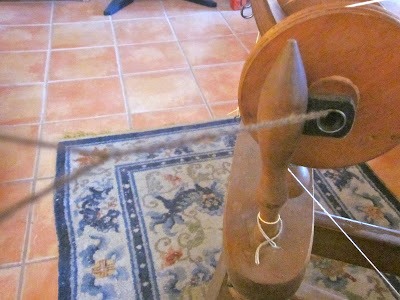For the previous posts on the Spinning Kai project, click here.
It seems that this project, spinning up a bunch of llama fiber for
Danni in Oregon, has taken far longer than it should have. Of course, life has intervened, and it wasn't just a matter of spending a straight week working on this pile of fiber. There were trips to be taken, friends to help move, blankets to knit, people to entertain, dinner parties to give and to go to, and so on. In other words, this project has been done in classic New Mexican Time--slow and easy.
At last, all the fiber was picked and carded. I had split the fleece that Danni sent into two parts, half for Danni and half for me. When Danni's part was all carded into
rolags (fluffy rolls of fiber), there were four or five baskets full of them. Here is part of one basketful in the photo below. This was before Keeker the cat decided to take a cozy nap in the basket. Ah, well, never mind. Kee enjoyed herself and the fiber was no worse for the experience.
The spinning wheel, which I had heedlessly stored out in the garage, needed weeks of coddling and oiling before it consented to work again. Never again will I treat it so carelessly: It will live right here inside the thick adobe walls of our little desert house--no more parching and baking out in the garage.
At first, when I couldn't get the old spinning wheel to work at all, I imagined that I might have to buy another wheel--very expensive now--in order to keep my promise to Danni. Then I thought I might have to use
a Navajo spindle and do the whole thing the
really, really slow way. However, the situation resolved itself as so many things do--I oiled and oiled and
oiled every part of the spinning wheel, and when nothing worked, just left it for a while. Amazingly, when I returned to the wheel a few days ago, I found that with a few quick adjustments, it worked just as well as it ever did.

Although the wheel isn't spinning yet in the photo above, you can see that I have attached the end of the rolag to the leader yarn, and have begun to draft it--pulling the rolag back and back, and back some more, feeding out the fibers in a "V," then allowing the spinning of the wheel to apply twist, which evens out along the length of the fiber. When it is all fairly even, I let it feed in through the orifice and around the bobbin.
It's a soothing thing to do, once you have the hang of it. Your foot rhythmically treadles the wheel which spins around, and you alternately pull the fiber back and feed it in. In my younger days, I found it very relaxing. Now I find that after a few hours I get a little achy, but it's still a pleasurable thing to do.
Now that all the fiber has been spun, in the next few posts I will show you the final steps in this process--plying, skeining, washing, and setting the twist. My sister keeps observing that it is ridiculously labor-intensive to make yarn this way, and she is right. However, it's a wonderful thing to know how to do.
Here is a very quick video that shows a newer version of the Ashford Traditional Wheel, which arrives as a kit, is put together, then put to work. The spinner in the video uses the
short draw technique of spinning, where the hands of the spinner are never very far apart.
I use the long draw method, demonstrated by the spinner in this video.
















